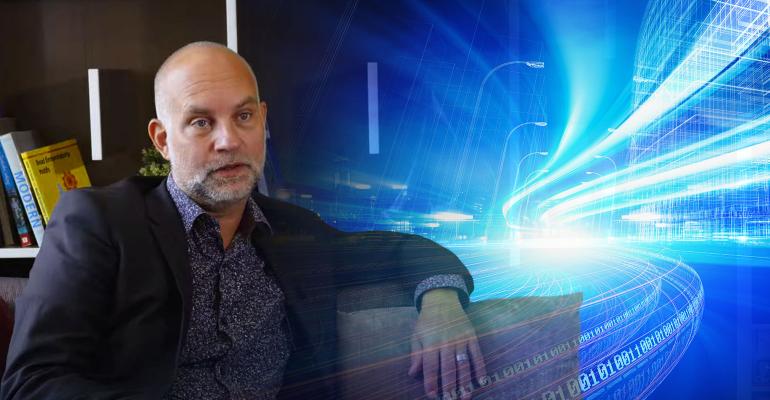Few can argue that technology is an enabler for innovation as its value has been realised through smaller roles or applications within the shipping industry, but what does this transition towards autonomous shipping look like?
Mikael Lind, Associate Professor and Senior Strategic Research Advisor with Research Institutes of Sweden (RISE), is a key player in several open innovation initiatives related to ICT for sustainable transportation of people and goods including Sea Traffic Management and Port Collaborative Decision Making (PortCDM).
He is also the co-founder of Maritime Informatics and is employed part-time at Chalmers University of Technology, Sweden.
Mikail has specialised in collaboration and data sharing in the maritime sector for the last 7 years.
We caught up with him after his presentation at Shipping Transformation Asia to find out more about the factors that will shape autonomous shipping over the next 5-10 years.
Watch the video now or read the transcript below.
Iain Gomersall: Currently, safety and security concerns are delaying implementation, but is the transition to autonomous shipping unstoppable?
Mikhail Lind: No, it is not stoppable at present and there are several investments in autonomous shipping. Maybe we will not see the realisation of complete autonomy, but I think we can be sure that there are many opportunities in digital twinning, artificial intelligence (AI), machine learning, and data sharing, etc. These developments will enable the shipping sector to become safer and more secure.
What we need to take into consideration are the regulations with regards to safety and security, which were written in times when digitalisation was not prevalent in the sector.
Q: How do shipping businesses innovate given the current regulatory conditions?
ML: I believe many of the opportunities undertaken by the bigger actors - the likes of Kongsberg and Rolls Royce - are showing how they are innovating within their realm of business using the different opportunities available to them and taking those forward.
I think companies like these are pushing the boundaries and pressing regulatory bodies to look at new frameworks which will be necessary as associated technologies develop. At RISE we have been talking about autonomous safety to be able to cope with the new regulations coming out of the IMO.
Q: Successful innovation needs data and purpose. Who will win shipping’s battle for data – shipowners, operators, ports, or end customers?
ML: Shipping is a very self-organised ecosystem, which means that several different parties are involved. What we need to realise is that maritime transport will always be part of a larger setting - the global transport and supply chains.
I don’t believe there will be a single winner in shipping’s battle for data.
All the actors need to come together, join forces and collaborate. Ships do not exist without ports, and ports don’t exist without ships. All parties will need to join forces for the benefit of the ecosystem.
Q: How will the shipping industry enable automation? What do you think are the biggest factors which will shape autonomous shipping over the next 5-10 years?
ML: Historically, there has been a lot of attention on how we should operate a ship optimally. We now see fleet operating centres which are becoming more sophisticated, and we have better weather prediction algorithms and route optimising software.
Most of this technology or software has had a focus on what is happening at sea, and what I think will enable and revolutionise autonomous shipping in the future will be the integration between port operations and ship operations.
I think as we bring the port into the equation as an important factor within the supply chain, this will stimulate the drive for autonomous shipping.
Q: Why is an event of this nature important to the industry?
ML: As discourse within the industry is becoming more focussed on collaboration and data sharing, there are more opportunities coming for digitalisation and automation. I think it is great that the questions are being addressed, and I’m happy that the organisers of the event are bringing this to the agenda.
I also see that there are several people coming back and we are seeing each other again – it has become a great networking event.
What is important, and what Shipping2030 and Global Liner Shipping are allowing us to do, is be present in one of the most important maritime centres in the world, Singapore.
This has enabled me to meet some of the key actors in Singapore.
Q: What kind of conversations have you had at the event?
ML: Firstly, I’m very happy to have had the opportunity to have met Thomas Bagge again from the DCSA. What the DCSA have been doing is very much aligned with what we are doing at the Port CDM council, and Bagge is representing nine out of the eleven largest shipping lines. We are representing what is of concern to ports to become optimised and co-ordinated.
The previously mentioned benefits will not happen unless several different players join forces.
Aside from that, we had a fantastic gathering yesterday with some of the conference representatives.
Copyright © 2024. All rights reserved. Seatrade, a trading name of Informa Markets (UK) Limited.
Add Seatrade Maritime News to your Google News feed.  |

